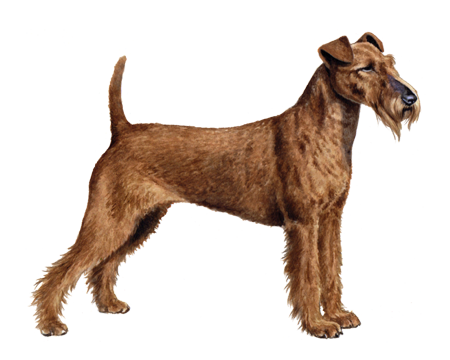
Scottish Terrier
Scottish Terriers are intelligent, alert, and active dogs. They're also incredibly loyal and affectionate to their family. This breed's high-spirited personality—along with an almost human-like charm—makes it an excellent companion.
Interested in discovering if your dog is a Scottish Terrier?
Check out Wisdom Panel's DNA tests.

Scottish Terrier Traits
General Appearance
A sturdy breed with a regal profile, the short-legged Scottish Terrier is widely considered a big dog in a small dog's body.
Coat and Colouring
The Scottish Terrier may be black, wheaten, or brindle of any color—as long as it always has black stripes. The breed may also have brown, red, or silver as the lighter shade. A small white chest blaze is possible, as are a few white or gray hairs peppering the coat.
Distinctive Physical Traits
The Scottish Terrier's head is characteristically long with perky, pointed ears that stand upright. It also has a bushy beard and eyebrows.
Scottish Terrier Temperament
Because of their hunting background, Scotties may bark, dig in the dirt, and chase wildlife. They can be tenacious or difficult to disengage from an activity, thanks to their stubborn streak.
Scottish Terriers are very friendly toward respectful, careful children. And they're loving and very protective over their family and territory. This trait makes them reserved—if not suspicious—of strangers. Scotties often don't get along well with other dogs.


Scottish Terrier History
Scottish Terriers date back to 1500-era Scotland. Originally developed to hunt badgers in the Scottish Highlands, Scotties had strong tails so their owners could pull them out of the holes they had dug.
The Scottish Terrier received official recognition in 1859 in Birmingham, England, and it reached its modern standard in 1879. John Naylor brought the Scottish Terrier to the United States in 1883. And the breed received American Kennel Club recognition in 1885.
Affectionately known as "Scotties," Scottish Terriers have been popular in the U.S. for decades—even among presidents, such as Franklin D. Roosevelt and George W. Bush.
Scottish Terrier Care
Nutrition
Scotties need a high-quality dog food that is age-appropriate. As you should with any dog, be sure to monitor how much your Boston Terrier consumes, and reduce portions if your pup gains excess weight. Also, remember that giving too many treats in addition to regular meals can contribute to obesity.
Grooming
An outstanding feature of the Scottie is its double coat, which requires regular grooming. Baths are only occasionally needed—unless your dog gets particularly dirty. Regular nail trimming and dental care should also be a part of your Scottish Terrier's grooming routine.
Exercise
To be happy, Scotties require lots of physical exercise. They are very playful, like to bark and dig, and appreciate anything that keeps them busy and active—whether it's a brisk walk, chasing a ball, or playing games. Because of their high energy levels, Scottish Terriers excel at dog sports, such as earthdog trials, agility, and tracking.
Training
A firm but gentle approach to training is best for Scotties, as they can be sensitive pups. You should start both socialization and training at an early age. To train your Scottie, begin with engaging, 15-minute sessions. This breed responds well to verbal praise and tends to get bored easily. Using a variety of teaching approaches is the recipe for success.

Scottish Terrier Genetic Health Conditions
-
Chondrodystrophy (CDDY) and Intervertebral Disc Disease (IVDD) Risk
Chondrodystrophy (CDDY) is a skeletal disorder characterized by shortened limbs and abnormal early degeneration of the spinal discs, or intervertebral disc disease (IVDD), which predisposes to disc herniation.
-
Craniomandibular Osteopathy (Discovered in Scottish Terrier breeds)
Craniomandibular Osteopathy (CMO), also known as "lion's jaw", is a disorder of the skull where the jaw bones show swelling and thickening, causing pain, drooling, and difficulties in eating.
-
Ligneous Membranitis
Ligneous Membranitis is a rare inflammatory disease of the mucous membranes. The disease causes conjunctivitis, mouth ulcers and swollen gums. Other clinical signs include nasal discharge, loud breathing and enlarged lymph nodes.
-
von Willebrand's Disease, type 3 (Discovered in the Scottish Terrier)
von Willebrand's Disease (vWD) Type 3 is a clotting disorder that causes severe bleeding tendencies in affected dogs.
Knowing if your Scottish Terrier is a carrier or at-risk for these conditions can help you and your veterinarian plan for your pup's lifelong care. With Wisdom Panel™ Premium, you can get results for over 200 genetic health tests.
Breed Group
Terrier
The Terrier Group ancestors were bred to hunt and kill vermin. They are often characterized as feisty and energetic dogs whose sizes range from fairly small to much larger.
Resources
https://www.google.com/books/edition/Scottish_Terrier/19kJBgAAQBAJ
https://www.akc.org/dog-breeds/scottish-terrier/
Reviewed 26 July 2020 by Cindy Elston, DVM, MPH































































